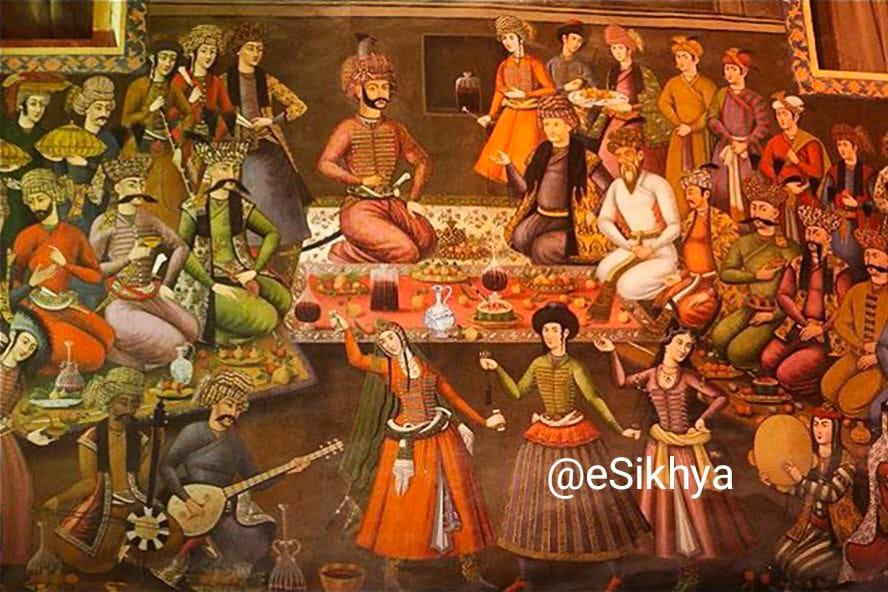Syncretic Traddition of Pre-Colonial Indian Political Thought
The syncretic tradition of pre-colonial Indian political thought is characterized by the blending and coexistence of diverse religious, cultural, and philosophical ideas. This tradition emerged as various empires and kingdoms integrated different communities and belief systems into their governance and cultural practices.
The most prominent syncretic traditions were developed during the Delhi Sultanate and the Mughal Empire, where Islamic rulers interacted with the predominantly Hindu population, leading to a unique fusion of ideas.
Syncretism in India has been driven by various historical, social, and cultural factors that have facilitated the blending of different religious, philosophical, and cultural traditions.
The following are key factors that have contributed to syncretism in India :

1. Historical Interactions and Conquests
- Trade and Commerce: Long before the establishment of major empires, trade routes facilitated cultural exchanges between different civilizations, including Greeks, Persians, Arabs, and Southeast Asians. Coastal regions like Kerala saw early interactions between Arab traders and local communities.
- Conquests and Empire Building: The establishment of the Delhi Sultanate and later the Mughal Empire brought Islamic culture into direct contact with the existing Hindu, Buddhist, and Jain traditions. The need to govern a diverse population encouraged rulers to adopt inclusive policies and cultural practices.
2. Religious Movements and Mysticism
- Bhakti Movement: This devotional movement emphasized personal devotion to a deity and transcended caste and religious boundaries. Bhakti saints like Kabir, Tulsidas, and Mirabai preached a message of love and unity, drawing from both Hindu and Islamic traditions.
- Sufism: The spread of Sufism in India, with its emphasis on mysticism, love, and devotion, created a fertile ground for syncretic practices. Sufi saints like Khwaja Moinuddin Chishti and Nizamuddin Auliya were revered by people of various faiths, and their shrines became centers of interfaith interaction.
3. Political and Administrative Policies
- Religious Tolerance: Rulers like Akbar implemented policies of religious tolerance, integrating people of different faiths into the administration and promoting an atmosphere of cultural exchange. Akbar’s Din-i-Ilahi, though not widely adopted, symbolized his commitment to syncretism.
- Mansabdari System: The Mughal administrative system, which included people of various religious and ethnic backgrounds, facilitated a culture of cooperation and mutual respect among different communities.
4. Cultural and Intellectual Exchange
- Translation Movements: The translation of texts between Persian, Sanskrit, Arabic, and regional languages facilitated the exchange of ideas. The Mughal court, particularly under Akbar, sponsored the translation of important Hindu texts like the Mahabharata and Ramayana into Persian.
- Educational Institutions: Madrasas and other educational institutions often taught a curriculum that included both Islamic and local knowledge, promoting a blend of intellectual traditions.
5. Art and Literature
- Literary Synthesis: Poets and writers like Amir Khusrau and Mirza Ghalib drew from both Islamic and Indian literary traditions, creating works that reflected the cultural synthesis of their times.
- Visual Arts and Architecture: Mughal architecture, which combines Islamic, Persian, and Indian elements, exemplifies syncretism. The use of local artisans and incorporation of indigenous styles resulted in unique structures that are celebrated to this day.
6. Social and Community Practices
- Interfaith Marriages: Marriages between individuals from different religious backgrounds, particularly within royal families, helped integrate diverse cultural practices and facilitated social harmony.
- Festivals and Rituals: Many festivals in India, such as Diwali, Eid, Holi, and Urs (Sufi festivals), are celebrated by people across religious boundaries, reflecting shared cultural practices.
7. Geographical Diversity
- Regional Variations: India’s vast geographical diversity, with its numerous regions and local cultures, naturally promoted a blending of practices. Each region developed its own syncretic traditions based on the interactions between local and foreign influences.
Examples of Syncretism in Practice

- Language Development: Urdu, a language that developed during the Mughal period, is a prime example of syncretism. It combines elements of Persian, Arabic, and local Indian languages and is written in the Persian script but spoken similarly to Hindi.
- Music and Dance: The development of classical music forms like Hindustani music, which incorporates Persian and Central Asian influences, as well as dance forms like Kathak, which reflects a blend of Hindu and Muslim traditions.
Conclusion
Syncretism in India has been driven by a confluence of historical events, religious movements, political policies, cultural exchanges, and social practices. This blending of traditions has created a rich and diverse cultural tapestry that continues to define the Indian subcontinent. The legacy of syncretism is evident in India’s architecture, literature, languages, music, and everyday social interactions, fostering a unique and enduring cultural heritage.
Share this content:



Leave a Reply